Pottery: Iron Glazes
Summary
Red iron oxide Fe2O3 decomposes to
iron monoxide FeO above 1000°C even in oxidising environments. Iron red is produced by
a surface growth of columnar crystals of
Fe2O3. Best reds are obtained by a
fast cool through the temperature range above 1000°C, where black FeO tends to form
crystals, to about 950°C where growth of red
Fe2O3 crystals is optimised. Oxygen
is required for this phase. Holding the temperature at 950°C for about an hour
produces the maximum coverage of iron crystals and best red colour. The colour deteriorates
with holds much longer than that, tending towards rust brown.
The more calcium there is in an iron glaze, the more difficult it is to obtain a good red,
however some calcium is required to get red from iron. To get a tomato red also requires
phosphorus; the red becomes more orange when magnesium is added to these two. The best
iron reds in oxidation firing are obtained with about 0.10 molar CaO, 0.03-0.06 MgO,
0.01-0.02 P2O5 and 0.08-0.12 FeO
Recent work
suggests that the surface of Fe2O3
crystals is actually Fe11O16, a much more
chemically active form. This may have something to do with the variances we see when using
iron glazes.
Literature
Colours reported
Black, tomato to rust red to muddy brown with green, honey, rust, rarely blue nuances
are reported in the literature. I have seen them all in my tests. I have only seen blues
as crust-like surface components; if they are crystalline, the crystals are to small
to see at 100x. I have never seen yellows or greens as a surface component, only as body.
Reds seem to appear solely as a crystalline surface layer.
Thickness of application
This is often mentioned as a major determining factor in colour of red iron glazes.
In my own work, I have found that a minumum thickness of about 50 µm is
required.
Cooling temperature
Cooling schedule is known to be important. Refiring to cone 04 is often
recommended to improve the red. Murrow (Ceramics Monthly Sept 2001) found that shino
glazes turned red only below 982°C.
Marians (Ceramics Monthly June/July 2007) found that temperature holds between
980°C and 870°C during the cooling cycle were critical to the development
of red in her iron glaze. She saw three components, one believed to be iron-rich
and two silica-rich, at low magnification. My own work confirms these findings,
that holds at 950°C for an hour during cooling produce the best reds.
Colour analysis
Murrow&Vandiver (noted in Ceramics Monthly Sept 2001) found that the red colour of
shino glazes came from a surface layer of ferric microcrystals about 20 µm thick.
Under this layer, the glaze was white. My collaboration with John Stirling found that in
iron glazes the surface is iron sesquioxide
(Fe2O3) while deeper iron is iron monoxide (FeO).
Park&Lee
(J.Ceram.Soc.Japan 113(1314):161-165 2005) found that in high
magnesia glazes the red colour is magnesioferrite
MgO.Fe2O3.
Calcia
Cardew (Pioneer Pottery) states that alkali earths must be minimised for an iron
red, that even 0.2 calcia will turn an iron glaze brown, and proposes a special
frit to this end. My work confirms this for calcia.
Magnesia
Park&Lee (op.cit.) found by X-ray
diffraction that in their glazes magnesia forms a red colour as magnesioferrite
MgO.Fe2O3, and that magnesioferrite
crystal formation is closely related to the presence of whitlockite-type crystals
Ca.9(Mg,Fe).(PO4).6(PO3OH).
Phosphorus seems to crystallize as whitlockite at 1000-1050°C, magnesioferrite
at 900-950°C. Edouard Bastarache (unpublished) considers that the presence
of dolomite (Ca,Mg)CO3 in iron red glazes makes better reds.
Soda
Hamer&Hamer (The Potter's Dictionary) mention that soda combined with small
amounts of iron produce blue, and that soda encourages red with large amounts of iron,
but give no details.
Phosphorus
Bone ash is reported by many to make more reliable reds; some use ferric phosphate
instead of red iron oxide and the bone ash (which contains a lot of calcia).
Boron
Hamer&Hamer (The Potter's Dictionary) mention that boron combined with small
amounts of iron produce blue, but give no details. Rhodes (Glazes for the Potter) mentions
blue from iron and boron; again no details.
Obstler (Out of the Earth, Into the Fire) mentions that boron increases green in iron
celadons; no details given. Hesselberth&Roy's Waterfall Brown (Mastering
Cone 6 Glazes) obtains green from iron; it has 50% more boron than usual
formulations, also more soda. True boron iron greens seem to require the near-absence
of calcia, which can only be achieved with frits since natural borates are half calcia.
Titania
Weyl (Coloured Glasses) notes that iron is green when it
is a network-modifier (equivalent of interstitial atoms in crystals), and that titania
moves it to brown by shifting it to a network former (the equivalent of taking part
in a crystal lattice). 4% titania achieved this in my experiments with the calcium
iron glaze below.
Migration of iron
There are two unpublished reports of sub-surface iron migrating to the surface of
glazes. Ron Roy has noticed this under strong reduction, but not in oxidation under
otherwise identical conditions. Hank Murrow believes that
fluorine in a glaze assists migration of iron to the surface and uses a percent
or less cryolite in his glazes to achieve this.
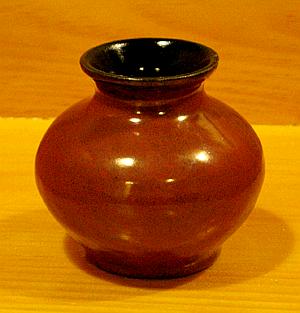 Sankey Iron Red
Sankey Iron Red
Custer feldspar 44g
silica 16.5g
bone ash 14g
red iron oxide 11g
EPK 10.5g
talc 10g
lithium carbonate 3
Bentonite 2g
COE: 6.8x10-6/K
calcia: 10% molar
Stoneware (Tucker Smooth White)
Source: Kevin Baldwin, adapted to local clays
Painted on bisque, fired cone 6 electric, one hour hold at 950°C. Vase is
7 cm high. A very even colour as long as it is thicker than 50 µm,
red crystals on a black ground with visual depth. It tends to black where it is thin.
By far the most reliable of the iron reds I've tried, and the one I've chosen for
my own dinner set. The expansion is high, but it works
perfectly on my clay, which is fairly low expansion
(6.64x10-6/K), probably due to the high potash content,
which increases both elasticity and tensile strength.
Microphotos are about 60x. X-ray analysis shows that all the crystals are
pure iron oxide;
Fe2O3 is the red, FeO the black.
Red crystals were analysed at three depths. The data shows that the result of the
950°C soak is primarily to oxidize the iron crystals on the surface to red
Fe2O3 while the buried iron
remains black FeO. This may be done by movement of oxygen to the surface under
chemical-strength forces or by surface oxidation. The glaze is far too viscous at
950°C to permit physical sorting of crystals.
| |
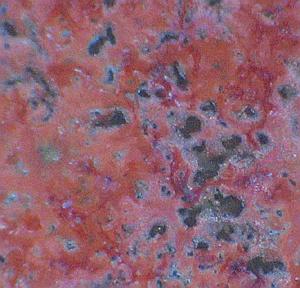
one hour hold at 950°C
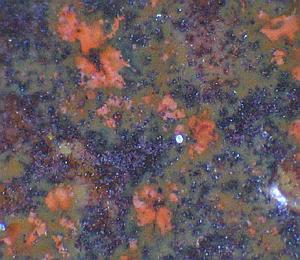
no hold
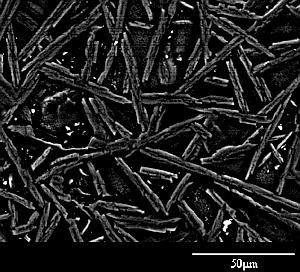
scanning electron microscope photo of
Fe2O3 crystals
|
Borate Iron Red:
Gerstley borate 32g
silica 30g
Custer feldspar 20g
red iron oxide 15g
talc 14g
EPK 5g
bone ash 6g
Bentonite 2g
COE: 5.6x10-6/K
calcia: 14% molar
Stoneware (Tucker Smooth White), thrown and trimmed.
Source: published many times under many names
Dipped on bisque, prefire thickness 0.47 mm.
Fired cone 6 electric, two hour rise to maximum temperature (1220°C),
held there for 10 min, kiln off until soak temperature reached (typically
30 min.), held there for a soak period, kiln off (5 hr to reach 200°C).
I did a series of runs with the same bowl, changing only the soak temperatures.
The first involved a long soak to fully develop all crystals that might be formed.
The microphoto (about 50x) shows that there are two types of components to this glaze.
One group forms very small crystals or crusts
on the surface; it forms a rust colour with long soak times. The other component
oozes out to the surface without crystalizing and is often yellow, sometimes
bright. It is probably ferrosilite (see below). Under certain temperature
regimes the ferrosilate is coloured a dull red by the iron. Bright colours
always seem associated with surface components; the two other microphotos
shown are typical of the variety of colours seen. X-ray analyses show that
the surface crusts are thinner than 4 µm, the effective penetration
depth of the 20 kV electrons used; reliable analyses could not be obtained.
Black gradually took over the bowl with repeated firings (the 980°C at right
was the eighth in the series). So, if you don't get the colour you wish with
this glaze, try refirings, but not too many. I obtained the most interesting
colours with moderate-length soaks in the 900-980°C range.
X-ray analysis of the final glaze (the 980°C photo) showed considerable fine and
medium-scale differentiation in the surface. There were large patches of nearly
pure silica (87%). Other patches had double the concentration of iron as the
total glaze formulation; all these were low in calcia. There was also evidence of
calcium silicate. It was not possible to match the X-ray image to an
optically-visible feature of the glaze.
In contrast to some reports, I found this to be a very well-mannered glaze as I mixed
it, not at all runny, or even droopy when laid on thickly, as you can see from the
lack of problems with the sharp horizontal edges of the 8 cm diameter
sugar bowl.
| |
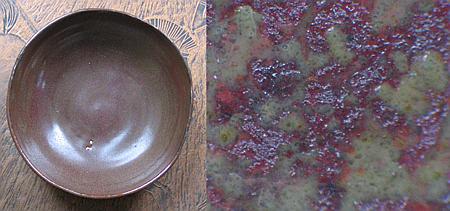
5 hr hold at 870°C
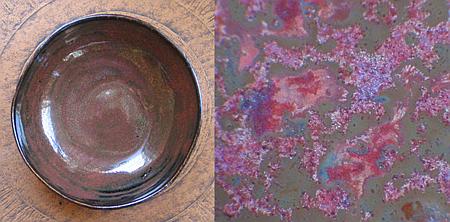
30 min hold at 940°C
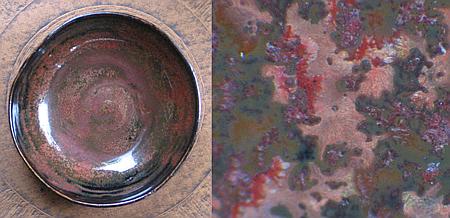
30 min hold at 980°C
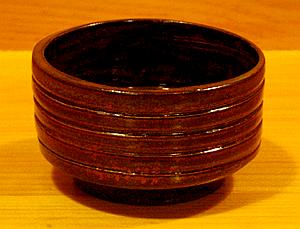
glaze painted thickly on the outside, thinly on the inside,
1 hr hold at 920°C
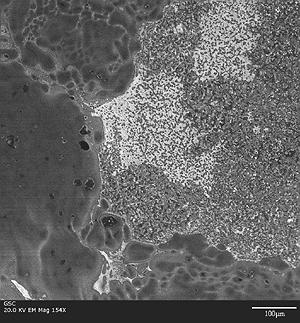
scanning electron microscope photo of a 0.7 mm square portion of the surface,
showing a typical crust-like differentiation.
|
Calcium Iron:
Wollastonite 28g
EPK 28g
Fusion F2 frit 23g
silica 17g
red iron oxide 7g
nepheline syenite 4g
Bentonite 2g
cobalt carbonate 2g
COE: 5.5x10-6/K
calcia: 17% molar
Porcelain (Tucker 6-50), thrown and trimmed.
Dipped on bisque, fired cone 6 electric. This began as an attempt at a matte lustre
black, but turned out to be a microcrystalline glaze. With the same bowl, a fast cool of
this glaze gives a glossy black, then a refire followed by a slow cool converts it to a
mottled black and green semi-matte, and vice versa. Green crystal size is dependent upon
cooling rate. Cooling from 1200°C at 50C/hr to 800°C produced crystals typically
2 mm in diameter. At 80C/hr the crystals were about 1 mm, at 100C/hr,
½ mm.
150C/hr is required to get a smooth surface, but then it's close to glossy.
Unless fired glossy, iron in excess of 7% comes out of solution to form a metallic layer
between the green crystals. Bowl is 10 cm diameter.
Besides the individual oxides, possible mineral compositions include Andalusite
Al2O3.SiO2,
Anorthite
CaO.Al2O3.2(SiO2),
Wollastonite CaO.SiO2,
Fayalite 2(FeO).SiO2,
Hedenbergite CaFe.2(SiO3) and
Ferrosilite FeO.SiO2.
[mineral photos]
The right half of the bowl is the result of a 10 hr soak at 1120°C after firing
to 1220°C. X-ray analysis shows that the crystals are FeO; as shown in the microphoto
(about 100x), they are mostly long rhombs. The surface is rough to the touch.
The left half of the bowl had a 10 hr soak at 870°C after firing to 1220°C.
This produces a surface layer of greenish-yellow crystal needles
that grow in six rays from a central point. The colour could match either
Hedenbergite or Ferrosilite, but the crystal form is most consistent with
Hedenbergite. The crystals are so thin that their X-ray output was mixed with
background material output, but it also indicates Hedenbergite.
Not an attractive or useful glaze.
| |
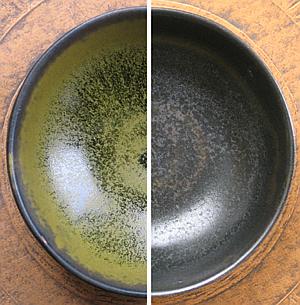
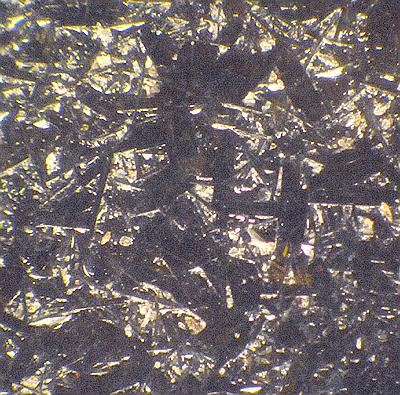
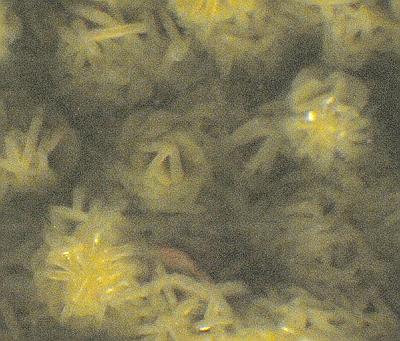
|
I thank John Stirling of Natural Resources Canada's Geological Survey for
making the scanning electron microscope guided X-ray analyses.
Iron Glaze Chemistry
To investigate the interaction of calcia, magnesia and phosphorus with iron in oxidising
fired glazes, a series of mixes were made. A base glaze contained none of any of the three
oxides under study, and one glaze each was made up similar to the composition of the base
glaze, but with a large quantity of each of the oxides in turn. The target analysis for
each was
3.5 Seger SiO2,
0.4 Al2O3 and
0.25 B2O3
(B2O3 and FeO omitted from Seger
ratios).
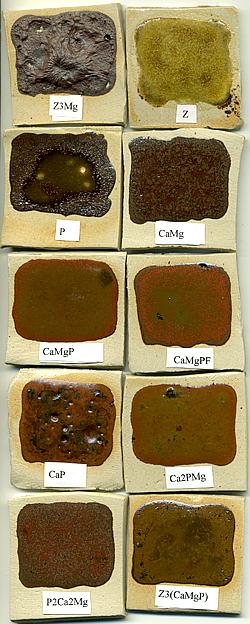
| mix | recipe | molar Seger oxide
|
|---|
| base
|
| 28 silica
| | 28 potassium carbonate
| | 24 kaolin,EPK
| | 10 iron oxide,red
| | 10 frit,Fusion 367
|
|
| 0.602 | 3.392 | SiO2
| | 0.166 | 0.935 | K2O
| | 0.102 | 0.575 | FeO
| | 0.010 | 0.059 | Na2O
| | 0.072 | 0.404 | Al2O3
| | 0.045 | 0.253 | B2O3
|
|
| magnesia
|
| 30 silica
| | 25 magnesium sulphate
| | 25 kaolin,EPK
| | 10 iron oxide,red
| | 10 frit,Fusion 367
|
|
| 0.611 | 3.497 | SiO2
| | 0.163 | 0.935 | MgO
| | 0.098 | 0.562 | FeO
| | 0.072 | 0.411 | Al2O3
| | 0.043 | 0.248 | B2O3
| | 0.010 | 0.058 | Na2O
|
|
| calcia
|
| 32 silica
| | 26 kaolin,EPK
| | 22 calcium carbonate
| | 10 iron oxide,red
| | 10 frit,Fusion 367
|
|
| 0.615 | 3.485 | SiO2
| | 0.166 | 0.939 | CaO
| | 0.094 | 0.533 | FeO
| | 0.071 | 0.405 | Al2O3
| | 0.041 | 0.234 | B2O3
| | 0.010 | 0.055 | Na2O
|
|
| phosphorus
|
| 27 silica
| | 26 potassium carbonate
| | 23 kaolin,EPK
| | 15 iron phosphate
| | 9 frit,Fusion 367
|
|
| 0.587 | 3.494 | SiO2
| | 0.157 | 0.936 | K2O
| | 0.100 | 0.596 | FeO
| | 0.070 | 0.418 | Al2O3
| | 0.041 | 0.246 | B2O3
| | 0.033 | 0.197 | P2O5
| | 0.010 | 0.057 | Na2O
|
|
Since the potassium and magnesium salts are hygroscopic (magnesium sulphate particularly
so), each of these was baked at 220°C until anhydrous before weighing. Each glaze mix
was then ground in a ball mill until uniformly fine. An attempt was made to use a
200 mesh seive on the dry mixes, but the hygroscopic-powered clumping of the soluble
salts made that impractical - lumps had to be taken out after mixing with the oil.
Each tile glaze was made with four 1/4 tsp portions (1 tsp=5 ml) of dry
material, using a precision stainless steel measure, then mixed with 3/4 tsp corn
oil. (Water could not be used due to the soluble salts required to separate the oxides.)
They were fired to 1290°C (cone 10), cooled to 950°C, then held there for
1 hr.
Since the best results were obtained with the maximum amount of phosphorus available
from these mixes, and calcium was shown to be required, a supplementary mix was made up
using bone ash (which contains calcium) to obtain larger amounts of phosphorus. Finally,
the ratio that gave the best colour response was tested with 0-25% added red iron oxide.
Some of the 54 test tiles are shown at right. Although not exactly decorative, they show
several useful results for oxidation firing above 1000°C:
- Although excess calcium is known to turn iron glazes brown, some calcium is required
to get red from iron.
- To get an intense red also requires phosphorus, but too much phosphorus turns the
glaze brown.
- The red becomes more orange when magnesium is added to these two, but too much
magnesium turns the glaze grey.
- The best iron colour responses in this series were obtained with 0.10 molar CaO,
0.03-0.06 MgO, 0.01-0.02 P2O5.
- Using a base with these proportions fired to cone 6, the best reds were obtained
with 9-14% added red iron oxide.
- 1% cryolite (fluorine) may help to brighten the red on the surface a bit, but gives
foaming to spitting problems during firing if used even slightly in excess or if
insufficiently finely divided.
I have located only one phosphorus-iron mineral that is red: Simferite
Li(Mg,Fe+++,Mn+++)2(PO4),
which is not a player since none of my test series contained lithia. Park&Lee
identified a magnesium-iron compound as their red. However, they seem to have concluded
that the role of phosphorus is to tie up calcia so it doesn't interfere with the formation
of magnesioferrite. It can't be as simple as that, since I got zero red from any glaze that
did not contain calcia, and only a trace of very dark red on glazes that contained calcia
but no phosphorus.
My current working hypothesis is that a calcium-phorphorus compound acts as a promotor
(perhaps catalyst) for the oxidation of FeO to
Fe2O3. It is possible that the two
instead tie up something else that inhibits the oxidation, but this seems less likely.
Notes:
The tests were originally planned for cone 6 and boron added that is usually
sufficient for it. Although the magnesium mix melted at cone 6, all mixtures with
it turned viscous and foamy as soon as they melted. Cone 10, the maximum for my kiln,
helped with some, but was still inadequate for a few.
Every stray cat in the neighbourhood was attracted to the kiln outside air vent
by the smell of the corn oil!
|
Microphotos
Here is the setup I use to take my microphotos.
My microscope is a basic full-size frame - no condenser, fine focus, stage movement or
anything else expensive. The objective is a 5x 0.1 NA - low NA gives large depth of
field, important for viewing solid objects. The eyepiece is a 10x periplan, selected from a
dozen brands in the store for clearest view over the field with this objective.
A point&shoot camera is placed on the eyepiece, moved from side to side until all the circle
of light from the microscope is visible on the screen, then zoomed until the edge of the
circular field just touches the edges of the view. That standardizes the magnification
of the photos so only one session with measuring scales is required. The microscope is
focussed until the image is sharp on the LCD, then the shutter pressed.
John Sankey 2008
other notes on pottery
other microphoto methods
| | 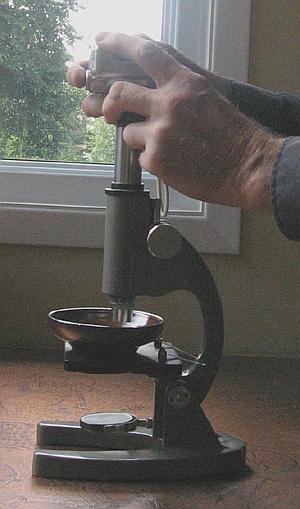
|
 Sankey Iron Red
Sankey Iron Red












